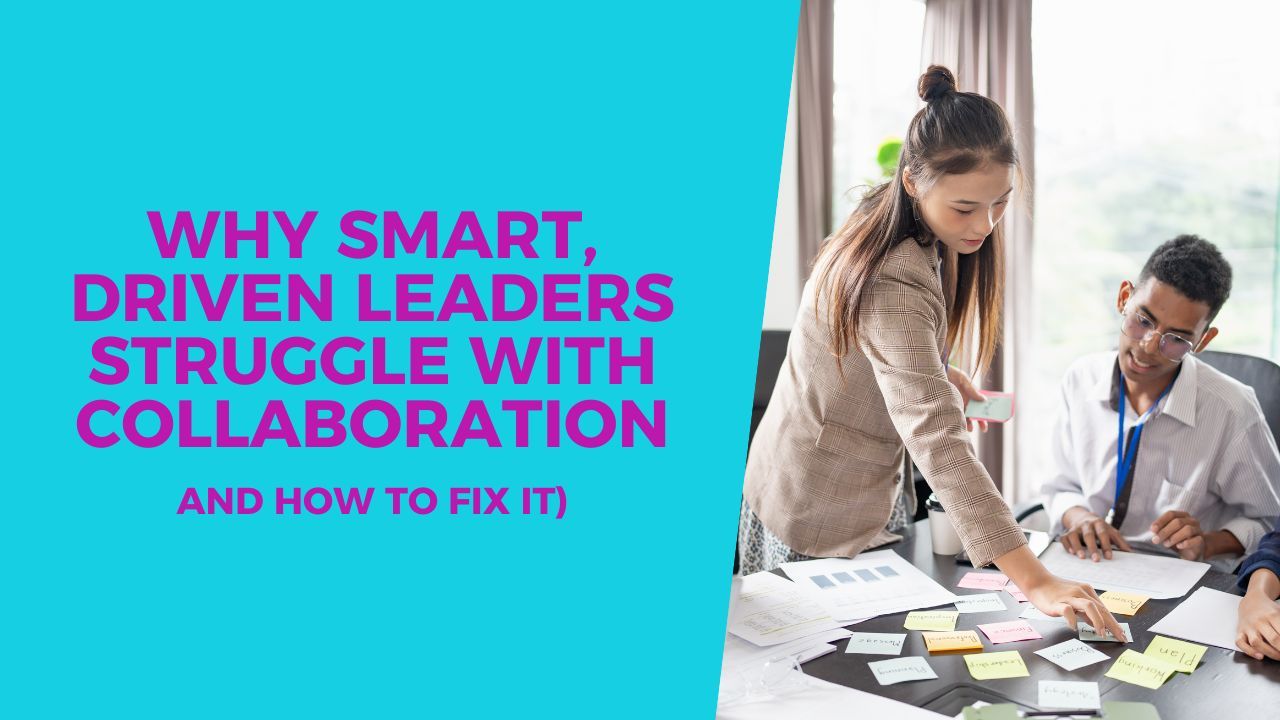Why Smart, Driven Leaders Struggle With Collaboration (And How to Fix It)
Nov 11, 2025
You know that feeling when you walk into a meeting and instantly realize you could do this faster on your own? Everyone’s debating, circling the same ideas, waiting for consensus—and your inner monologue starts screaming: “Can we please just make a decision and move on?”
You’re not a control freak. You’re efficient. You’re a doer. You get stuff done.
So when teamwork feels like spinning wheels in mud, your brain doesn’t see “collaboration.”
It sees chaos—and it goes into stress mode.
So let’s break it down:
You’re not bad at collaboration. You’re just wired for performance, not patience.
And that wiring is pure biology.
The High-Performer Paradox: When Strengths Collide With Stress
If you’re a driven, high-achieving leader, your brain has been rewarded your whole life for action.
You solve problems, anticipate needs, hit goals, and thrive under pressure.
Your body actually likes that stress—it gives you a dopamine hit every time you deliver results.
The problem? Collaboration activates the opposite side of your wiring.
It’s slower. It’s ambiguous. It requires emotional bandwidth instead of just tactical execution.
To your nervous system, that feels like friction.
Here’s what’s really happening:
When you sense inefficiency or lack of clarity, your amygdala (the threat center of the brain) fires up.
Adrenaline and cortisol flood your system.
Your prefrontal cortex—the logic and empathy center—starts to dim.
And suddenly, you’re tense, irritable, and trying very hard not to say something like,
“If you’d all just let me do it, we’d be done by now.”
You’re not broken. You’re biochemical.
Your body is reacting to perceived loss of control, not difficult coworkers.
And because you’re wired to perform, your tolerance for inefficiency is razor thin. That’s why collaboration can feel physically uncomfortable. The same brain chemistry that fuels your drive for excellence also heightens your sensitivity to delay and ambiguity. Once you recognize that discomfort as chemistry—not conflict—you can reset it, reframe it, and turn collaboration into a high-performance advantage instead of a stress trigger.
Control vs. Connection: The Real Tug-of-War
Under stress, we default to control.
It’s not ego—it’s self-preservation.
Your brain is wired to minimize uncertainty. When you’re in fight-or-flight mode, control feels like safety.
Unfortunately, collaboration thrives on the opposite: connection.
When stress triggers an adrenaline rush, the brain temporarily shifts away from oxytocin-driven trust and connection toward self-protectionThat’s why even well-meaning leaders start interrupting, micromanaging, or taking the reins.
Their biology is simply prioritizing survival over synergy.
You can’t build trust when your chemistry still thinks it’s in combat.
You can’t access curiosity, creativity, or compassion when your body is locked into defense.
And here’s the irony—control might make you feel productive, but it actually drains performance in the long run. When people sense tension, they withdraw, stop offering ideas, and mirror your stress response. The faster you can shift from control to connection, the faster you reintroduce the chemistry of trust—and that’s where innovation, engagement, and genuine collaboration start to flow again.
To shift from pressure to partnership, you have to turn off the stress signal and bring the prefrontal cortex back online.
Luckily, it doesn’t take long.
Here are three quick chemistry resets I teach that change collaboration in real time:
1. Breathe Out Longer Than You Breathe In.
Your exhale is your built-in “off switch.”
Inhale for four, exhale for six. Repeat three times.
That longer exhale flips your nervous system from fight-or-flight to rest-and-recover iwithin minutes. Do it before a meeting, during a tense conversation, or right after someone challenges your idea.
It’s invisible, fast, and incredibly effective.
2. State the Shared Goal.
When the conversation gets heated or stuck, pull back to the bigger purpose.
Reaffirming a shared goal or higher purpose activates neural circuits linked to cooperation and reward. When people feel psychologically safe and aligned, oxytocin goes up, reinforcing trust and empathy.
Say it out loud:
“Let’s zoom out for a second — what’s the real goal we’re solving for?”
“I think we all want this to succeed. Let’s find the path that gets us there fastest.”
“We’re not opponents here — we’re collaborators trying to unlock the same outcome.”
These simple sentences redirect focus from self-preservation to collective success.
3. Ask Instead of Assume.
When stress spikes, curiosity dies.
We start filling in gaps with worst-case assumptions.
Reverse it.
Ask one question that starts with “Help me understand…” or “Can you walk me through…”
Asking questions sparks curiosity, which activates the brain’s dopamine-based reward system and can help shift attention from stress toward learning and problem-solving. Suddenly, the same conversation that felt like friction becomes forward momentum.
The Collaboration Reframe: It’s Not About Playing Nice
Collaboration isn’t about being agreeable—it’s about being adaptable.
It’s not about dimming your drive; it’s about directing it.
When you reset your chemistry, you create the internal space to think clearly, listen actively, and respond strategically.
That’s how you shift from controlling the outcome to influencing the process.
And the best part? You still get results—only now, they come with less tension, fewer late nights, and more collective wins.
From Burnout to Bandwidth
If you’re ready to lead without losing your energy—or your mind—start by exploring my free science-backed tools and trainings for high-performing professionals.
They’re designed to help you reset your stress chemistry, sustain focus, and thrive under pressure.
Because collaboration, confidence, and clarity all start in the same place: your biology.
Explore From Burnout to Brilliance: 5 Days to Reignite Your Energy and Passion
10 Micro Strategies to Boost Your Energy & Resilience
Instead of reaching for that candy bar or cup of coffee, here are 10 QUICK & EASY WAYS you can increase your energy and resilience by changing your chemistry and physiology.
Just let me know where you want me to send them.
We hate SPAM. We will never sell your information, for any reason.


